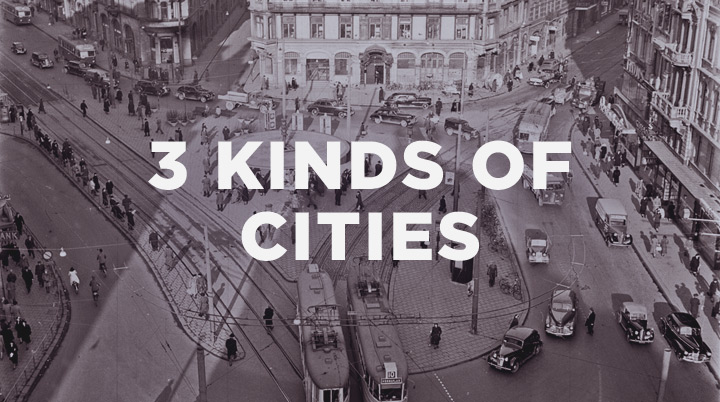Latest
-
Objections to the Christian Faith from the Unchurched and De-Churched
 Tue Dec 02, 2014
Tue Dec 02, 2014
by Resurgence -
Craig Groeschel: We Innovate for Jesus
 Tue Oct 14, 2014
Tue Oct 14, 2014
by Resurgence -
Mark Driscoll: Revelation
 Tue Oct 07, 2014
Tue Oct 07, 2014
by Resurgence -
RESURGENCE LEADERSHIP #034: JOHN PIPER, WHY I TRUST THE SCRIPTURES, PART 2
 Tue Sep 30, 2014
Tue Sep 30, 2014
by Resurgence -
Resurgence Leadership #033: John Piper, Why I Trust the Scriptures, Part 1
 Tue Sep 23, 2014
Tue Sep 23, 2014
by Resurgence

Archives
3 Kinds of Cities

Knowing the kind of city you live in will help you better communicate the gospel to the people who live there. What kind of city do you live in?
At a recent Q&A session with pastors, I got a lot of questions about cities. I tend to be a verbal processor who thinks out loud, and in the course of my response, something rolled out of my head that I had never really put together before. I thought it might be helpful to share, particularly as there is an increased interest in urban ministry and church planting in “upstream” metropolitan areas where culture tends to be created and sent out.
And where you find people, there’s an opportunity to bring the good news of Jesus.
Cities are marked by density (i.e., more people per mile) and diversity (i.e., incomes, languages, religions, life stages, education levels, etc.), but beyond these broad criteria, there are at least three kinds of large cities:
First Cities
People go to first cities to land their big time job, make their mark, and establish their career with a résumé-making opportunity. People tend to go to these cities for college and then stay to start their career, or they move to these cities after college while still single. Most people who move to first cities do not intend to remain for the rest of their lives.
Examples of major first cities include New York, Los Angeles, San Francisco, London, Sydney, and Tokyo. Further down the list would be places like Seattle, Austin, Dallas, Atlanta, Houston, Minneapolis, and Boston. If you land a serious job with a serious firm in a serious city you have serious options for your future career. This explains why these cities attract a lot of college students and college-educated professional singles.
Second Cities
Once you’re looking at getting married, having kids, buying a home, and settling down, you move to a second city. Second cities offer good career jobs. They’re situated near a major airport for business travel. And they’re more suitable for families, with schools, parks, family activities, and reasonable housing.
Second cities are places like Denver, cities within Orange County, Phoenix, Raleigh, Charleston (South Carolina), Salt Lake City, Indianapolis, Little Rock, San Diego, Albuquerque, and Boise. These cities tend to have a lot of families with decent incomes and a high quality of life.
Third Cities
Once your kids are grown and scattered by college and career, you no longer need your big house. The career is winding down. And you’re more likely to be financially stable and ready to enjoy some good weather in a place where the cost of living is reasonable.
Third cities are scattered in places such as Arizona, Southern California (e.g., Palm Springs), and South Florida—all home to a lot of retirees and empty nesters.
Every city is different
When it comes to influence, first cities enjoy national and international influence and culture-making clout. The influence of second and third cities generally extends to the surrounding region.
While these categories may provide a helpful paradigm, some cities may exhibit characteristics of each because no two cities are exactly alike. Some cities are older, and others are younger. Some cities are rich, and others are poor. There are some cities with kids, and others with hardly any. Some cities lean conservative, others liberal. Some cities are made up of many homeowners, while renters are common in other cities.
Wherever there is a city, you’ll find people. And where you find people, there’s an opportunity to bring the good news of Jesus. If you know your context, chances are you’ll be more effective in this important mission.
Additional resources on cities and urban ministry:
- "Urban and Missional," by Mark Driscoll (sermon)
- “How to be on mission in the city,” by Stephen Um
- “10 things to know about planting a church in the urban context,” by Jerome Gay Jr.
- "Christians should love, not forsake, the nation's cities," by Mark Driscoll